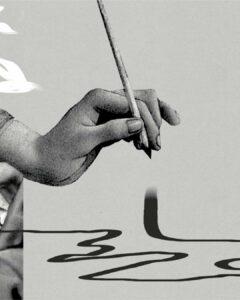
Listen to the article.
Mainstream narratives on war and peace tend to reduce young people to passive victims of circumstance, overlooking their agency, attitudes and lived experiences. While children and adolescents in Armenia have been deeply affected by war in recent years, their perspectives remain largely absent in the public discourse.
After the 2020 Artsakh War, I began leading photography workshops at Tumo Center, where I met and learned from teens across Armenia and Artsakh. Many of them, including those in Yerevan, were experiencing personal and collective grief. Some had lost loved ones, while others were coping with fear or displacement. Yet, I noticed how these shared experiences took on different forms based on geography and proximity to the border.
Visual artist and fellow workshop leader Narek Barseghyan and I began exchanging reflections about our observations. At the time, we were both grappling with our own unresolved feelings about war—its aftermath, its lingering presence, and the quiet anxieties it had planted about the future. We found ourselves pondering the contrasts between young people in Yerevan and those in the regions, realizing how little we truly knew about youth in border communities––places where armed conflict is not just a looming threat but a formative element of childhood, where borders both visible and invisible shape their lives and identities.
This shared concern became our point of departure. In the winter of 2023, we traveled to the villages of Movses and Chinari in Tavush region, both affected by the July 2020 skirmishes along the Armenian-Azerbaijani border. We wanted to hear young people’s stories and perspectives on war, peace and life along the border, and the shrinking landscape of Armenia, all in their own words and grounded in their lived realities. We were there to learn. This shared curiosity evolved into a long-term visual and narrative inquiry, taking us on a journey from these two mountainous villages in northeastern Tavush to the southernmost Syunik, culminating in an exhibition in Yerevan titled “Growing up on the Border.”
Home, Belonging and Fear
One of the recurring observations during my conversations with youth from Armenia’s border communities has been their deep-rooted sense of familiarity and safety with their immediate surroundings, despite their proximity to potential danger. Many of those who grew up amid active ceasefire violations and making routine visits to bunkers since kindergarten speak of feeling safest at home––even when that home stands just kilometers from the Armenia–Azerbaijan border.
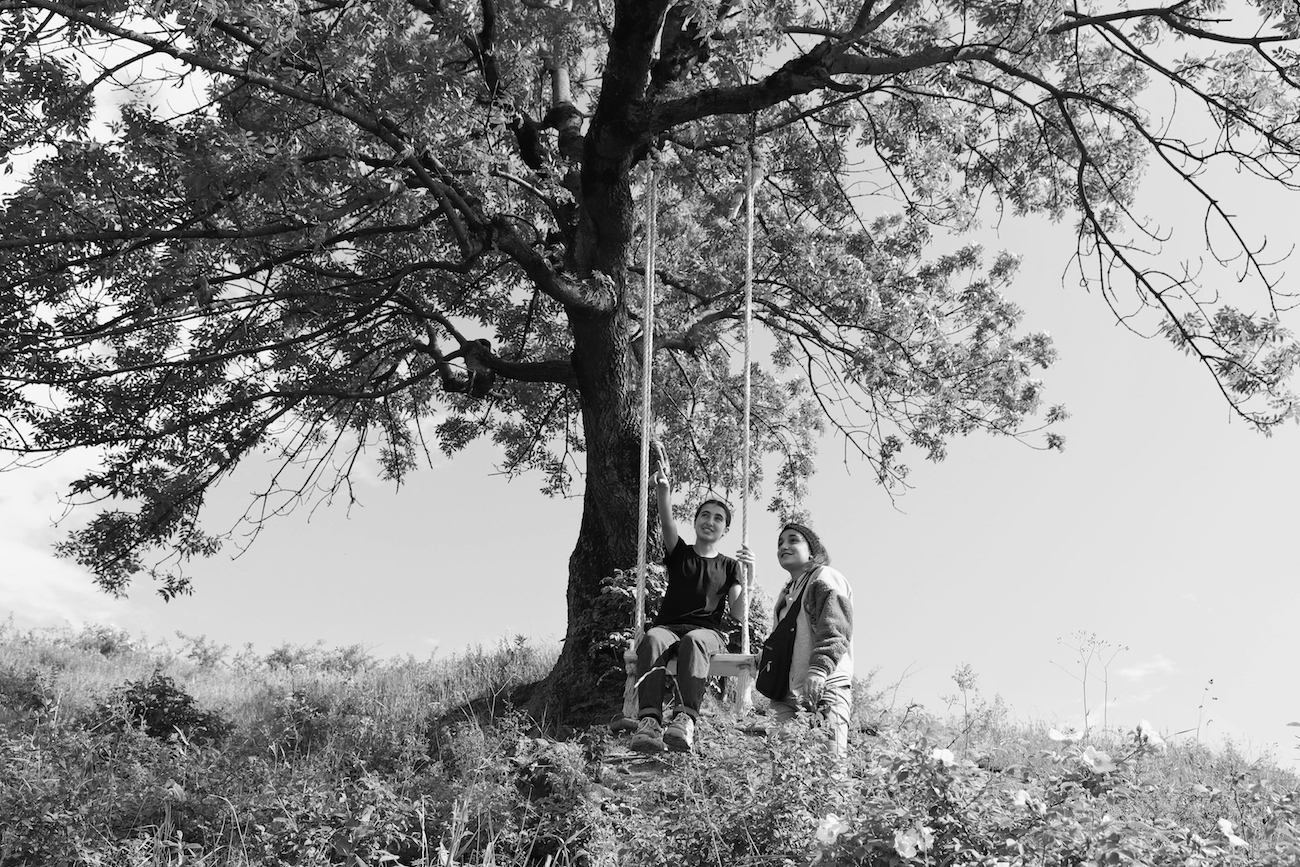
Araqs and Ani, 16, on a hilltop swing overlooking the Armenian-Azerbaijani border. Chinari, Tavush, 2023.
“The fact that Chinari is on the border makes me want to live here. If everyone leaves to flee the shooting, it will empty. And if it is empty, it will be easy to capture. I am convinced that if we want the border to be strong, there must be residents here–people who guard the border. I want my future home to be here.
“During the July clashes we were at home, but they took us to Aygedzor, the neighboring village, against our will. Honestly, I felt safer in our home––even though a drone had exploded not far from our house––simply because it was ours. When you’re born into these circumstances, they become your normal. No matter what, you stay because this is home. While in Aygedzor, I worried constantly about my dad and grandparents, especially since my grandpa was helping fight fires. I was anxious that another drone could strike the same location again.
“Fortunately, I didn’t lose anyone, but the psychological impact is inevitable. We still aren’t at peace. At any moment, an air raid siren could force us to rush to shelter. There’s no peace when 120,000 people, including some of my own friends, remain trapped in a blockade. There’s no peace when my friends from Artsakh can’t return home for the holidays. There’s no peace when 120,000 people lack food, medicine and basic necessities for survival. There’s no peace when everyone lives with the fear that war could break out at any moment––and that if it does, we won’t survive it.
“Peace isn’t something others hand to us, we have to claim it ourselves. On a personal level, if we don’t take time to be alone with our thoughts, to listen deeply and understand ourselves, we won’t find inner peace. And on the state level, if we don’t grow truly stronger, neither Europe, nor America, nor Azerbaijan will grant us peace.”
Araqs, 16
Chinari, Tavush
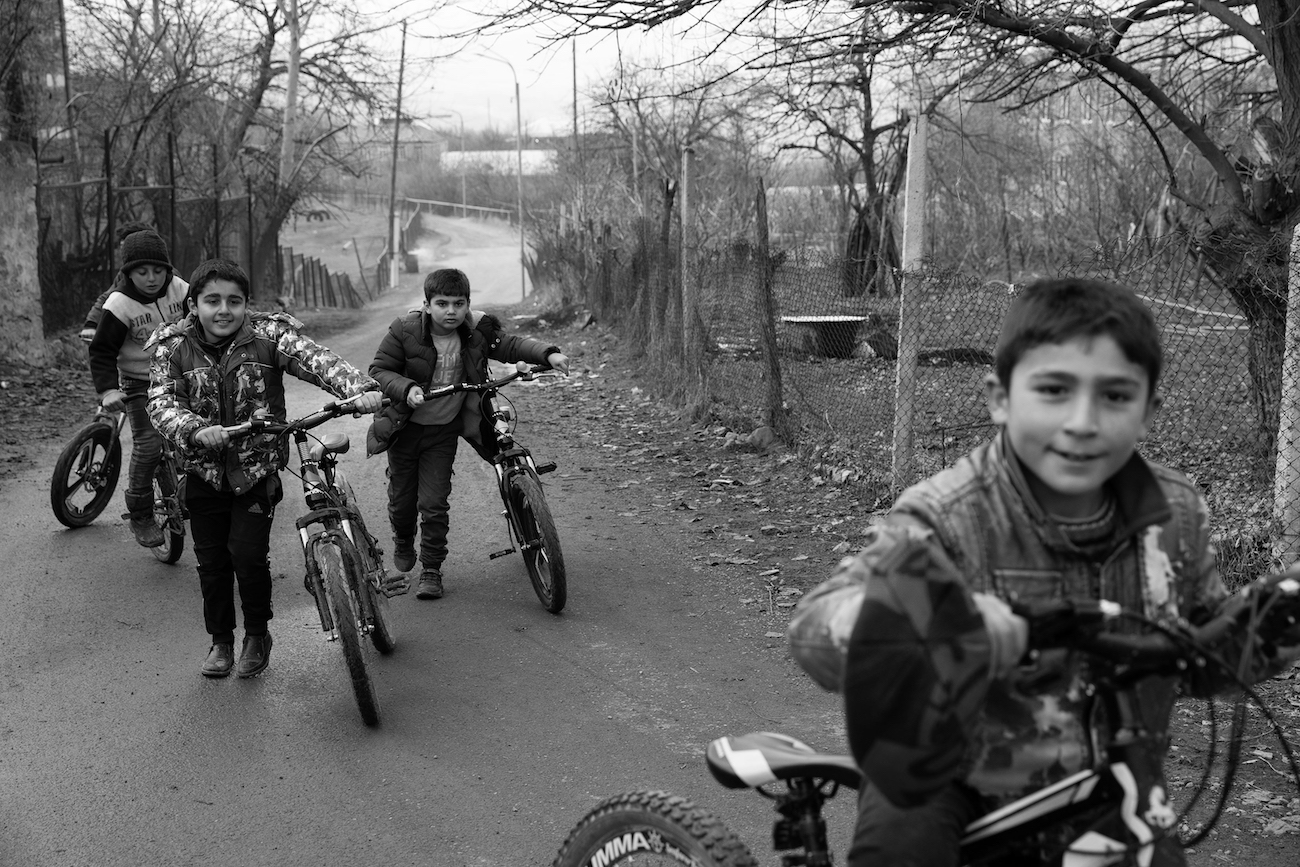
Boys cycling after school. Chinari, Tavush.
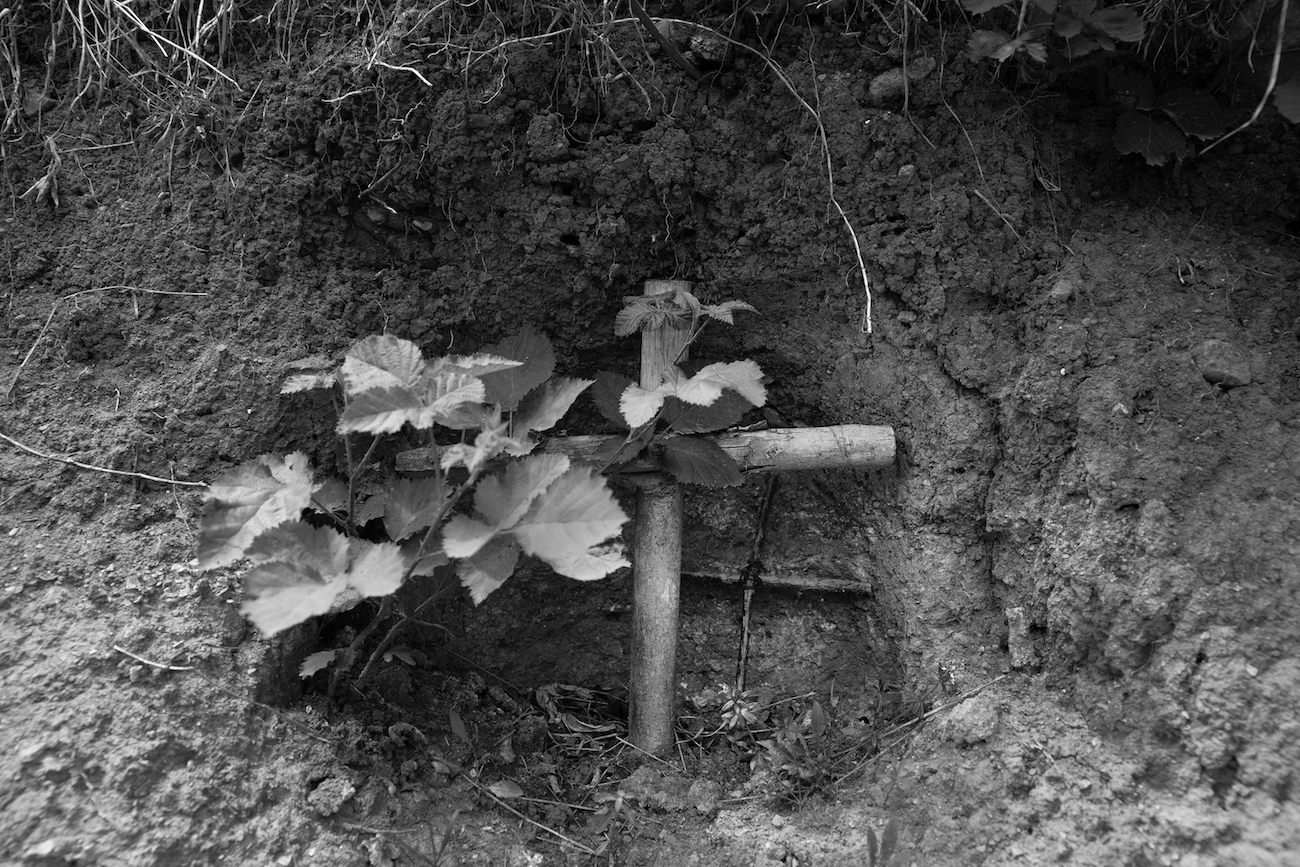
A wooden cross made by soldiers. Chinari, Tavush.
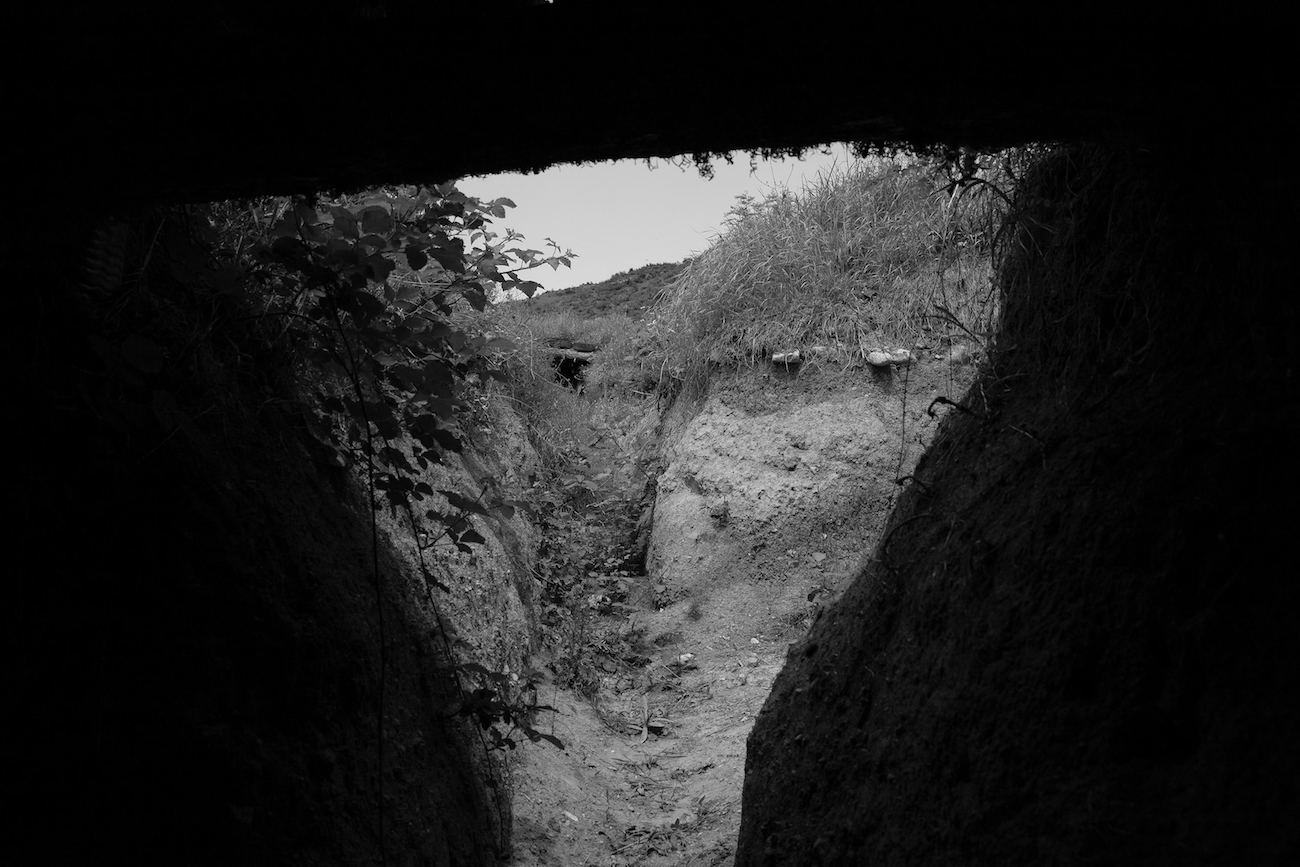
A temporary trench dug during the 2020 July clashes on the Armenia-Azerbaijan boarder.
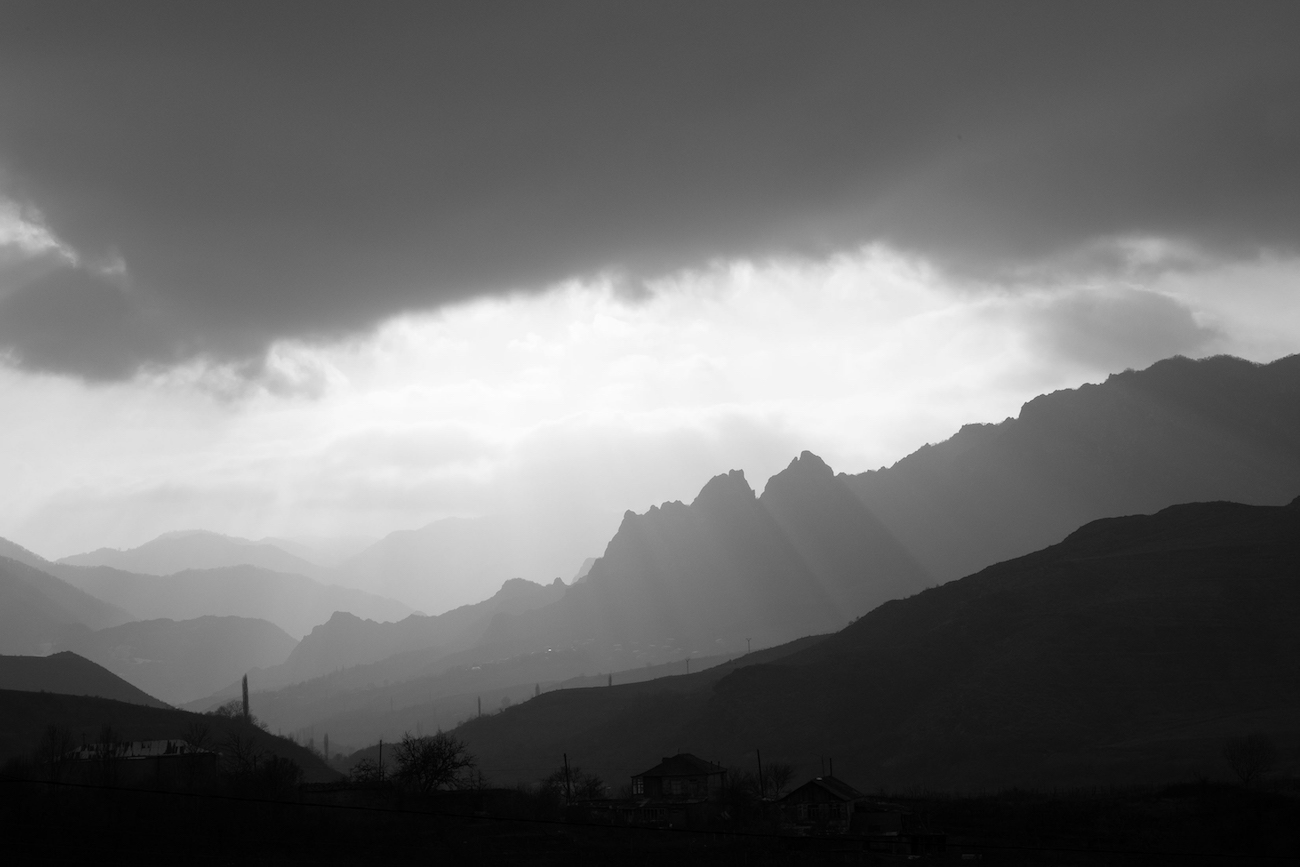
A view from the village of Chinari, Tavush, 2023.
***
For young people living far from the line of contact, the 2020 Artsakh war transformed their perception of danger. It heightened feelings of vulnerability and instability, even in areas previously thought safe from frontline violence. This was true for 21-year-old Shushanik, who grew up in the village of Araks in Armenia’s Armavir region along the Turkish border. Though her area wasn’t considered high-risk, the post-war atmosphere altered her sense of security and brought geopolitical tensions into her everyday life.

Shushanik enjoying mulberries in her village. Araks, Armavir, 2023.
“When I was little, we used to visit the border during school trips. Usually, only a couple of soldiers were stationed there. But whenever they found out about our school visits, they would prepare by sending more troops. In reality, just one or two people guarded the border.
“I remember wanting to be on the other side of the border, but only to see Mount Ararat. It’s so close you can see it clearly- right across from us. You can even see it beautifully from my bedroom window. I’ve always wanted to see it from the other side. When I was younger, I felt no fear. The anxiety came later, particularly after the 2020 war. That’s when I moved to Yerevan, though even there, I didn’t feel entirely safe.
“I was in the village when the war began. With all the misinformation on social media, we believed we were winning. I stayed, thinking it would end soon. We learned that if one man in the family volunteered, the other wouldn’t be drafted. My dad volunteered so they wouldn’t take my brother. He was gone for fifteen days, but it felt like fifteen years. During war, even the most distant people suddenly matter deeply- you just want to know everyone, even those who seem insignificant, is safe.
“2020 forced me to grow up. Before that, I was carefree, focused on getting into university to become a diplomat. I got in with genuine excitement, thinking I’d become a diplomat and defend my country’s interests. But afterward, I realized I didn’t want to be anything at all in this country, because I felt like I wouldn’t be able to change anything anyway. I don’t feel that way anymore, though. I now believe we each have a role to play in what matters for our country.
“When I visit the village, I go to bed in fear. I can barely stay for a day. I don’t know what kind of fear has taken hold of me. It feels like none of us are safe in Armenia—anything could happen at any moment. [Before the war], my room was the one place where I felt safe and at peace. It was my home. But since 2020, I don’t really have a home anymore. I can’t envision the future; I wake up wondering what’s going to happen next. The news devastates me. I spend entire days anxious and angry, especially at the government for what they’re doing, or rather—not doing.”
Shushanik, 21
Araks, Armavir

Mount Ararat behind barbed wire on the Armenia-Turkey border as seen from the village of Araks, Armavir.
***
While Shushanik’s sense of loss of home and stability is more symbolic––rooted in a shifting sense of safety––for many displaced young people, the loss of home is quite literal. Fourteen-year-old Nare was born and raised in the village of Aghavno, Artsakh. After the Azerbaijani takeover of the village in 2022, her family settled in the border village of Tegh, Syunik region. Nare recalls her last days in Aghavno.
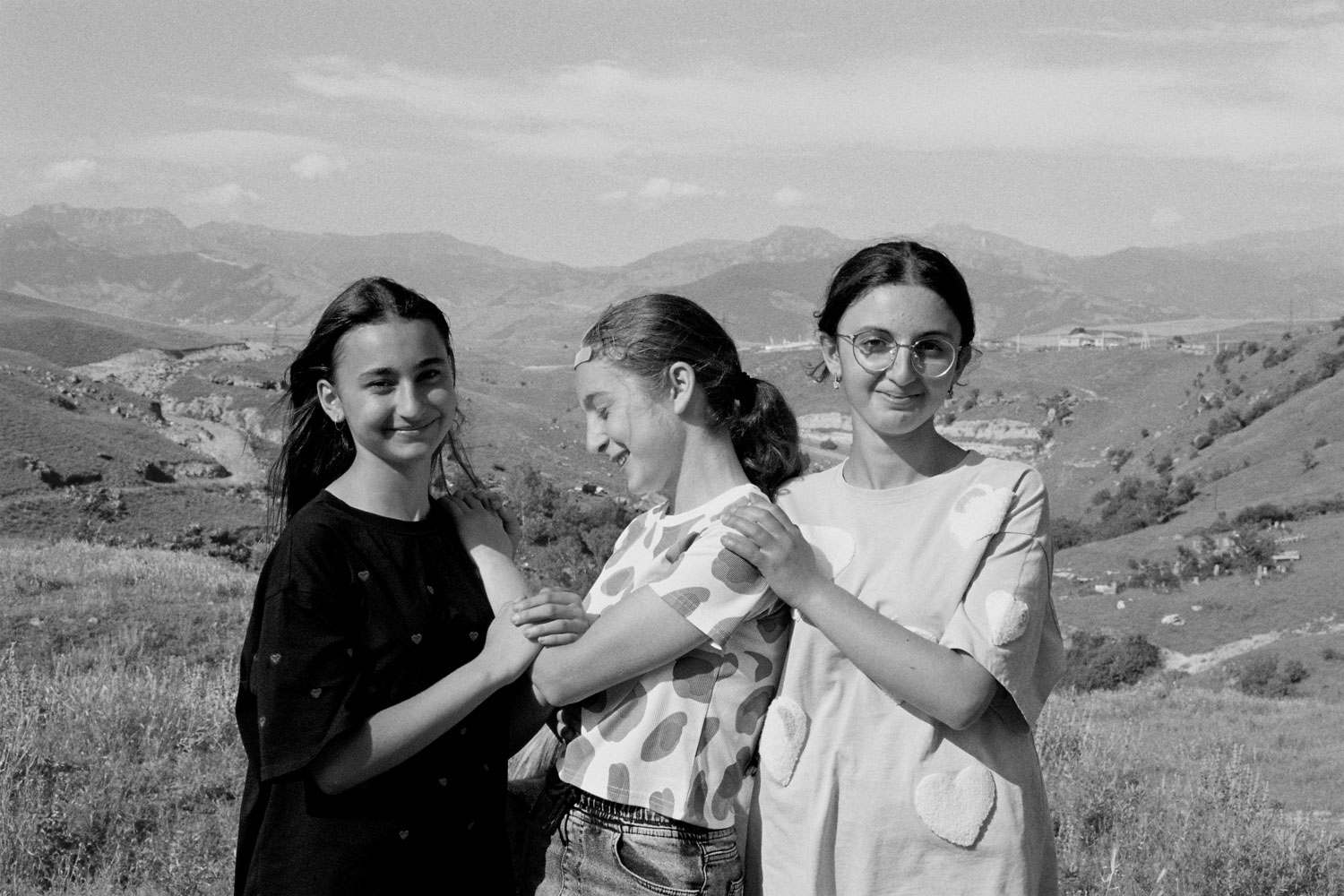
Nare (center) with her friends Ashkhen and Astghik in the border village of Tegh, where her family settled after the handover of Aghavno to Azerbaijan. Syunik, 2024.
“It had only been a year since we got our new house in Aghavno. I remember that day clearly––there was so much joy. I had started decorating the house with big dreams, wondering what it would look like in a few years, whether the village would change, whether we would still be there. I especially remember my birthday. We gathered at our house with friends— about ten or twelve of us—and we all squeezed into my dad’s tiny car to go swimming in the river. I’ll never forget that day!
“Starting July 28, after Prime Minister Pashinyan’s speech, journalists began arriving at the village. They asked us questions, but we still weren’t sure whether the village would actually be handed over to Azerbaijan. While we were in Aghavno, the electricity was frequently cut off––we had no power from 8 a.m. until 8 p.m. They [Azerbaijanis] were throwing metal scraps into our drinking water reservoir to contaminate it with harmful bacteria. They did everything they could to make people feel fed up and abandon the village.
“In early August, the Minister of Territorial Administration and Infrastructure announced we had to hand over the village to Azerbaijan, but added, “Whatever you do, don’t burn your houses, because we’ll come back one day.” Around that time, I was supposed to attend a camp in Vanadzor. Though I went, each time I called home, I felt more and more heartbroken. Every conversation with my mom made it clear they were gradually emptying the house.
“By August 15, I was back home. The Hayordi Camp called and said, ‘Since the village is being handed over, we want to take the kids away so they don’t have to witness this painful moment.’ I refused to leave. I said, ‘I’m staying here until the very last day.’ From August 15 onward, we had no electricity or water, forcing us to fetch water from the nearby village of Tegh. On August 21, we left the village. Only the fire service and police remained––the police stayed to make sure no one set their homes on fire. My parents kept saying they wanted to burn the house, but they couldn’t bring themselves to do it. Watching their home burn from afar would have shattered their soul even more.”
Nare, 14
Aghavno, Lachin
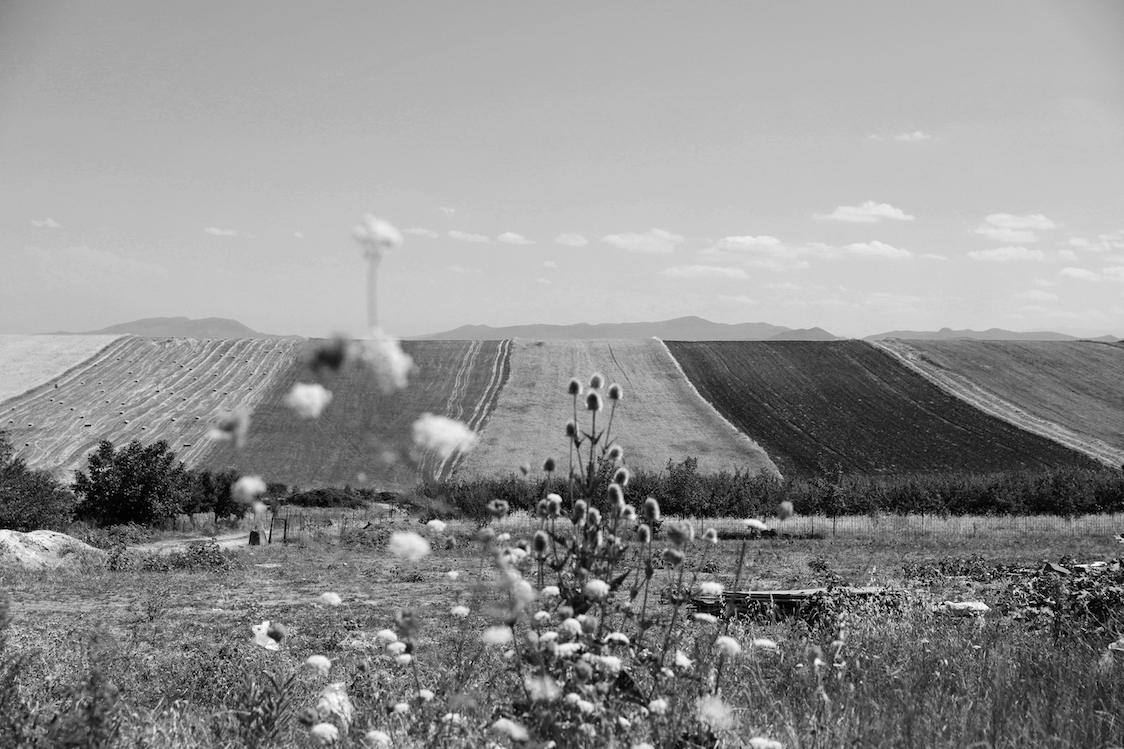
Agricultural fields in Nerkin Khndzoresk, Syunik region. Artsakh is behind the fields.
***
Mountains, Militancy and Manhood
For 18-year-old Tigran from the village of Movses, becoming a soldier has been “my life’s dream.” He speaks with pride about his father, who became a fedayi at the onset of the First Karabakh War, joining other men from the village to defend their homes. These stories of courage and sacrifice have shaped Tigran’s imagination since childhood. Yet he openly acknowledges the emotional weight this legacy carries. Having witnessed signs of psychological trauma in both his father and maternal uncle, he understands why his family hesitates to support his aspirations to become a contract soldier. Still, for Tigran, military service represents both a personal calling and a way to honor a generational legacy rooted in the defense of homeland.
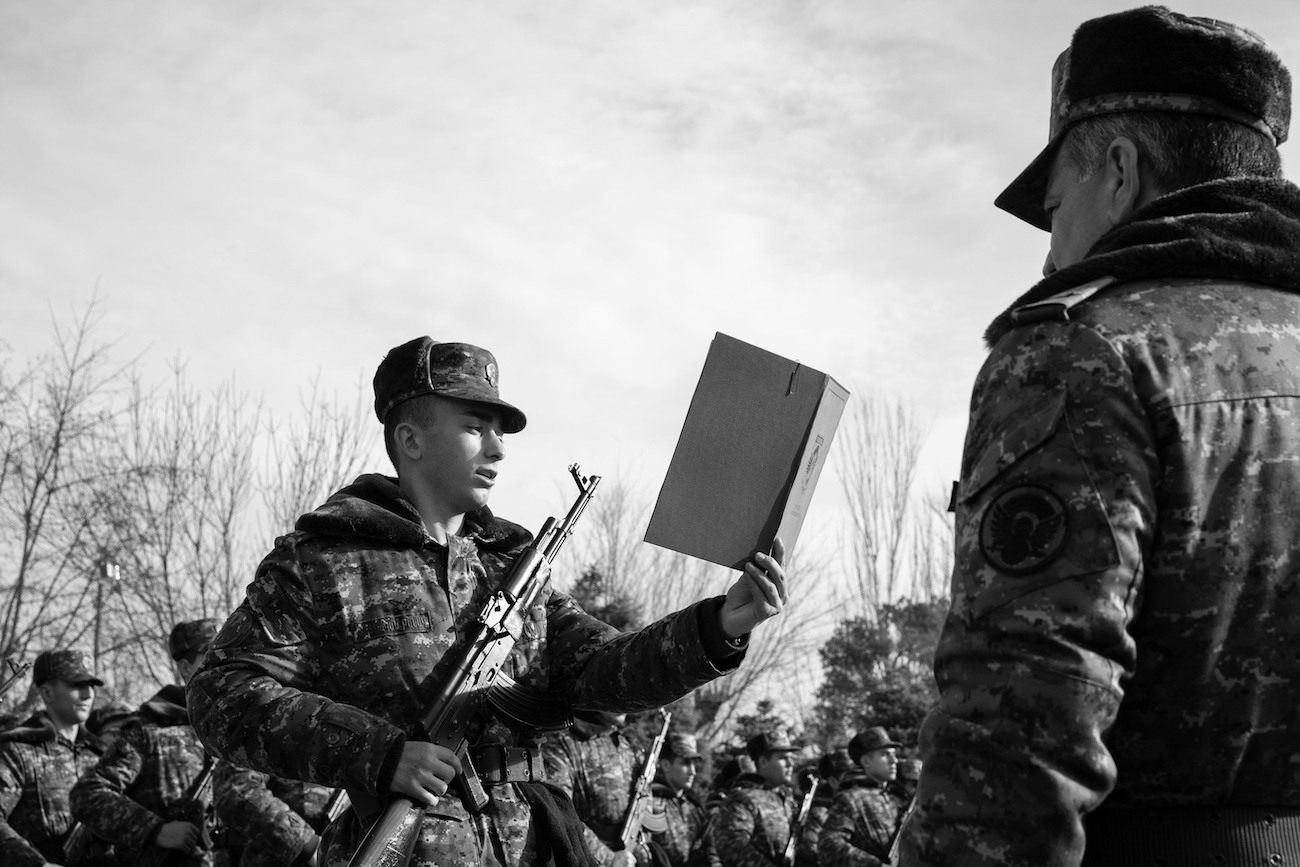
Tigran, 18, from the border village of Movses, taking his military oath. Yerablur Military Memorial Cemetery, Yerevan, 2024.
“My parents want me to become an economist, but I want to be a serviceman. I’m preparing to apply for a law school, though that’s not what I truly want either. If I’m not accepted, I’ll pursue the military path. It’s my dream to become a serviceman, even though my parents are against it. My dad was also a soldier; he fought in the Artsakh war and helped defend our village. When the war was over, he became a contract serviceman.”
Tigran, 18
Movses, Tavush

A group of young men seeing their friend off to military service. Movses, Tavush, 2023.
***
In Armenia, military service is commonly seen as both a responsibility and a marker of manhood—an expectation reinforced by family, community, and the state, and often internalized through narratives of patriotism and national duty. In many villages and towns near the Armenia–Azerbaijan border, men frequently work as contract servicemen due to the lack of viable employment alternatives. Children grow up surrounded by soldier-fathers, soldier-uncles, soldier-neighbors, making the figure of the uniformed man central to daily life.
Young men’s exposure to the military begins long before they take their military oath or start mandatory service. In the aftermath of the 2020 Artsakh war, self-defense initiatives like VOMA have gained significant popularity among Armenian youth. These programs, which teach first aid, survival tactics, and defense skills, attract both boys and girls. Many young men eventually take on leadership roles, guiding younger participants.
Beneath this apparent norm lie doubts and contradictions—not all young men embrace the path of the soldier. Some quietly voice their doubts, while others express reluctance to participate in a system they did not choose. A few question the meaning of giving one’s life not just for the country, but within a political reality that remains uncertain.
Twenty-one-year-old Narek from Chambarak, Gegharkunik region, has spent three years in limbo, awaiting a decision on his mandatory military service. After graduating high school, he began working at the local bakery to become financially independent and support his family. Unlike many of his peers, Narek takes a more critical view of conscription. His reflections reveal a quiet resistance to the idea that military service should be an unquestioned part of every young man’s journey, especially for those already burdened by economic hardship.

Narek, 21, has been waiting for three years for a decision on his compulsory military service. Chambarak, Gegharkunik, 2024.
“Not everyone has the same background here—there are people who are poor, middle class and upper class. Some kids might grow up without facing any real hardships, but others have been through a lot from an early age, and that shapes how they think. I guess young people from the mountains grow up faster. I don’t know how else to put it. In Yerevan, someone might stab someone else over something stupid. Here, most guys end up signing military contracts. They’re stationed at the border. Then there are people like me, who’ve had their service postponed, so we work in shops or go to the city [Yerevan].
“If I go to the military, my life may turn out differently. Most guys here become contract soldiers. If I go, that’s probably what I’ll do too. If not, I’ll have to consider other paths. Between 18 and 20, guys feel invincible. That age was chosen perfectly for the army—you just follow orders without really understanding why. But when you get older, you start to realize what’s really happening. Did those guys die for nothing?
“Those security decisions aren’t up to us. If they were, we’d do whatever it takes to keep our land. But in reality, others decide everything and our role means nothing—you might go and end up dying for nothing. I used to think every guy must serve in the army, but many friends who served say it’s not worth it, and if you can avoid it, you shouldn’t go. They’ve seen what it’s like and feel that way. Maybe if I went, I’d feel differently. I don’t know. Living peacefully with Azerbaijanis seems impossible, but there should be clear borders, with no side advancing. What’s ours is ours, what’s theirs stays theirs.”
Narek, 21
Chambarak, Gegharkunik
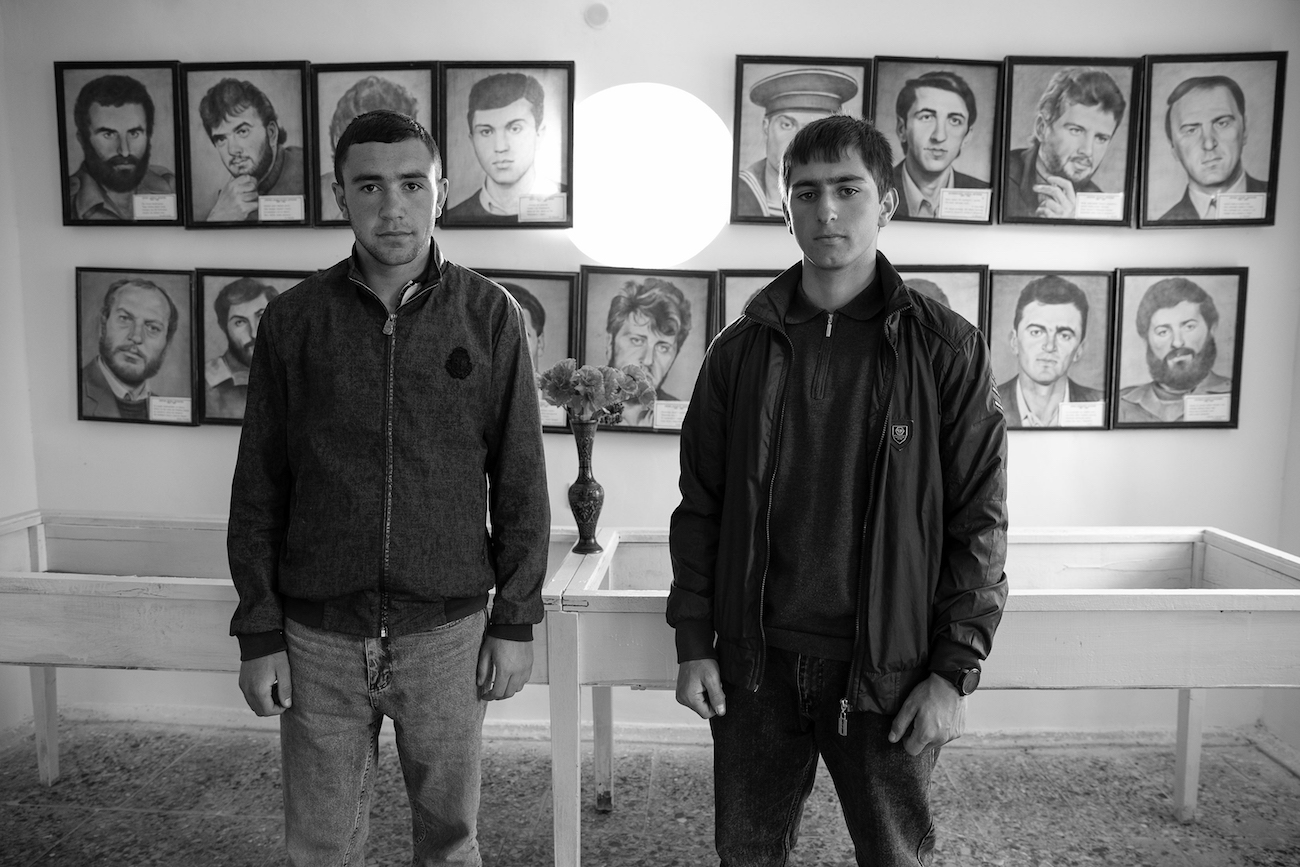
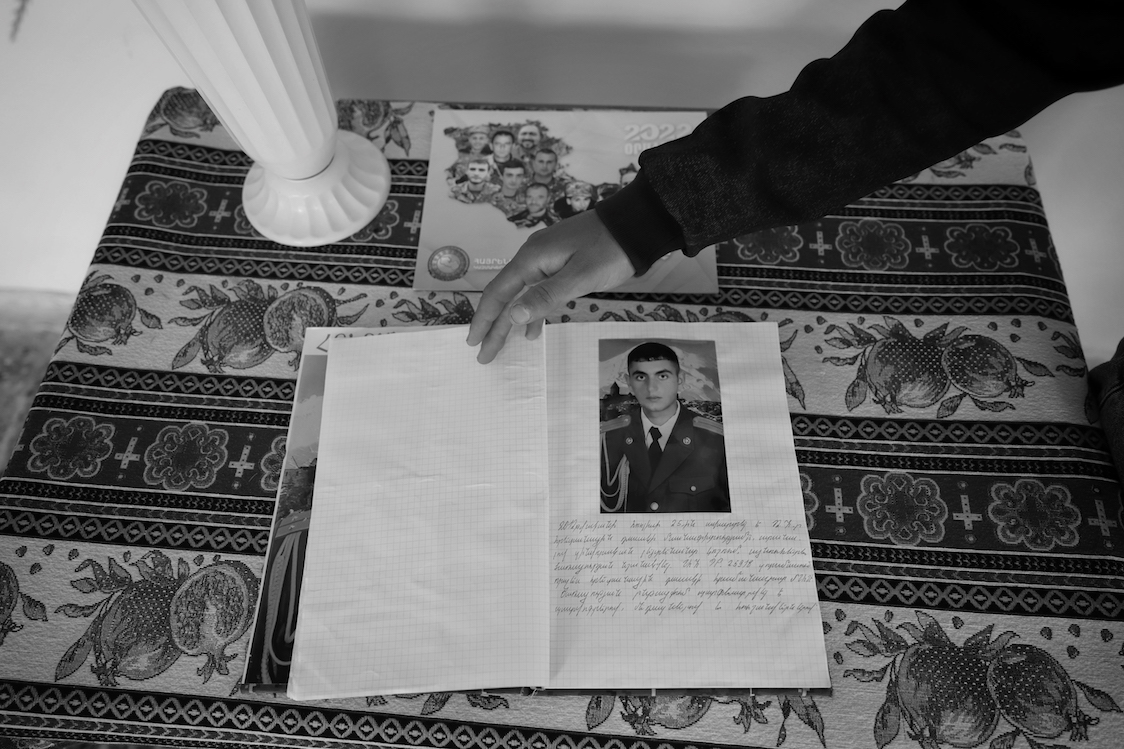
Levon (18) and Artyom (17) at the local memorial dedicated to fallen soldiers. Vahan, Gegharkunik, 2024.

The Armenian flag flutters over the village of Vahan, Chambarak community in Gegharkunik, 2024.
Photographs by Gayane Ghazaryan.

